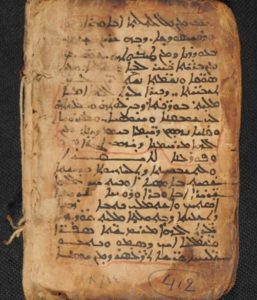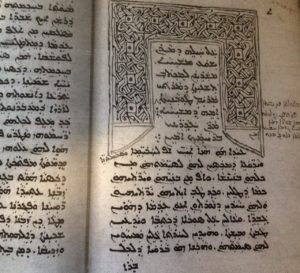Lost and Found Items in Manuscripts of the Life of Mary
I have spent much of the past ten years working on a project that has been mentioned on this blog several times (start HERE): a critical edition of the Infancy Gospel of Thomas in Syriac. The project is now virtually complete; right now it is in the hands of readers and I look forward to getting their feedback in the next few months. In the meantime I thought I would use some of the downtime to get back to blogging with more regularity. And what better to write about than, once again, the Syriac Infancy Gospel of Thomas?

In the course of my manuscript hunting and gathering, I came across some manuscripts that should be of interest to a wider audience of scholars than the few of us who work on Infancy Thomas. This is one of the joys of text-critical research: the serendipitous discovery of texts or versions of texts obscured, in many cases, by sloppy cataloguing—because the cataloger either missed or misidentified the material. Several of the West Syriac Life of Mary manuscripts included in my project contain additional texts on the Virgin Mary—e.g., Jacob of Serug’s memra On the Death and Burial of the Virgin, or the Miracle of the Theotokos in the City of Apamea. In a few cases, one of these texts—a memra On the Malice of the Jews against Mary and Joseph, sometimes attributed to Ephrem—is inserted between books one and two of the Life of Mary (book 1 is Protevangelium of James 1-16; book 2 is Prot. Jas. 17-25). But since many of the Life of Mary manuscripts have suffered damage in the first (and often the last) pages, it is not always clear that Malice is present in the collection, and thus it slips the cataloger’s attention. A similar problem occurs in another manuscript—Mosul, Mar Behnam Monastery, MBM 20—this time of the Sa recension of Infancy Thomas (the Sa manuscripts feature Infancy Thomas as a distinct, separate text, and not as book four of the Life of Mary). The manuscript has not been formally catalogued but after it was photographed for the Hill Museum and Manuscript Library, Adam McCollum described the manuscript in a blog post for Hmmlorientalia as containing Prot. Jas., Infancy Thomas, and the Dormition of Mary. The manuscript has numerous pages missing and disordered, so it is no surprise that McCollum did not notice that Prot. Jas. is not present in the manuscript after all; rather, the text he read was Ps-Ephrem’s Malice. At first sight, I did not recognize the text either and thought perhaps it was a newly-discovered infancy gospel. Alas, a closer reading proved that it was a known text, though one rarely discussed in scholarship.
Another Mary-related text found in the Life of Mary manuscripts is a memra On the Departure of Mary, sometimes attributed to Timothy of Gargar. When looking for information about the hymn on the extremely helpful resource Syriaca.org: The Syriac Reference Portal, I noticed that there were two texts of this same name and with the same incipit: one attributed to Timothy of Gargar and the other to John of Birtha. It became clear that these were in fact the same text, a fact confirmed by Anton Baumstark’s brief mention of the dual attribution in his Geschichte der syrischen Literatur. I informed the editors of Syriaca.org about this oversight and, likely, they will correct the references for future readers. This is another joy of working with manuscripts: being able to contribute to the storehouse of knowledge about not only the text on which you are working, but other texts as well. In addition I provided Syriaca.org with two supplements to their gazatteer: a reference to the rarely-attested Yangija from the colophon of Columbia University, Butler Library X893.4 B47 (dated 1796) and a peculiar designation to Sophene from Charfeh, Syrian-Catholic Patriarchate, Fonds Rahmani 42 (dated 1495).
One of the Life of Mary manuscripts contains another seldom-studied text: the Syriac Apocalypse of Daniel. The text was edited by Matthias Henze (The Syriac Apocalypse of Daniel: Introduction: Text and Commentary, Studien texte zu Antike und Christentum 11 [Tübingen: Mohr Siebeck, 2001]) based on a single manuscript: Harvard, Houghton Library, Syr. 42. I came across a second copy of the text in a manuscript from Mardin and passed the information on to Henze, who hopes to be able to use it to clear up some faulty readings in the Harvard manuscript.
My investigations into the Syriac Infancy Thomas also led to the rediscovery of several manuscripts believed to be “lost.” These manuscripts were catalogued late in the 19th century by Addai Scher and others but, with the upheaval in the East during the two world wars, many manuscripts were transferred to other locations, or sold, or destroyed. When I began my work on Infancy Thomas I had a short list of these missing manuscripts; now that list is considerably shorter, thanks largely to the efforts of HMML to photograph the current contents of the libraries of the East. Two particular manuscripts of the Syriac Life of Mary, however, remain elusive. They were catalogued by Scher in two separate articles as Diyarbakir, Meryem Ana Syriac Orthodox Church, 99 and Mardin, Chaldean Bishopric, 80. According to Scher, they both contain 140 fol., measure 13 x 9 cm, and were created in the time of the patriarch Ignatius Masud, who reigned from 1493 to 1512 (Baumstark, however, gave precise dates for these manuscripts as 1728-1731, though it is not clear why). There is good reason to think these are the same manuscript, but if that were the case, wouldn’t Scher have known? To complicate matters further, a manuscript with the same contents and physical dimensions was photographed by HMML and catalogued as Mardin, Church of the Forty Martyrs, 265. Unfortunately, Mardin 265 does not have a colophon indicating its time of origin, but the HMML compilers assign it an origin in the sixteenth/seventeenth century; scribal notes also reveal that it once belonged to a certain Simon, and one page bears the stamp of the Deir al-Zafaran. Could all three be the same manuscript? At the very least it seems that they were produced, or better mass-produced, according to exact specifications, in roughly the same location and around the same time.

The most important re-discovered manuscript is one obtained at Alqosh by E. A. W. Budge and used for his 1899 edition of the East Syriac History of the Virgin. This text is another compilation of Mary-related apocrypha beginning with Prot. Jas. and ending with the Dormition. In between there are stories of the Holy Family in Egypt (found also in Arabic Infancy Gospel, which seems to be a translation of the Syriac text) and in Budge’s manuscript, much of Infancy Thomas. Budge collated the Alqosh manuscript against a manuscript of the Royal Asiatic Library which features a shorter reading of the text lacking Infancy Thomas and several large portions of Dorm. Vir. Ever since Budge’s death, scholars have declared the Alqosh manuscript missing. But, ever the completist, I hoped to be able to find it so that I could verify his readings. Much of Budge’s work ended up at Christ’s College in Cambridge, but they informed me that no Syriac manuscripts are included in the materials. Then, just a few months ago, I happened upon a detailed description of a West Syriac Life of Mary manuscript—Vatican, Borgia Syr. 128—posted online by Kristian Heal (“Vatican Borgia Syriac 128: A New Description”). In his notes, Heal identifies Budge’s History of the Virgin manuscript as University of Leeds, Syr. 1. As it turns out, the nine Syriac manuscripts owned by Budge were bequeathed to the British Library in 1934, purchased at a Sotheby’s auction in 1970, and were soon after purchased by the Department of Semitic Studies at the University of Leeds, where they remain today. The collection was catalogued by Rifaat Ebied in an article from 1974 (“Some Syriac Manuscripts from the Collection of Sir E.A. Wallis Budge,” in Ignacio Ortiz de Urbina [ed.], Symposium Syriacum 1972: célèbre dans les jours 26-31 octobre 1972 à l’Institut Pontifical Oriental de Rome, Orientalia christiana analecta 197 [Rome: Pontifical Institutum Orientalium Studiorum, 1974], 509-39), but no-one, it seems, besides Kristian, was aware of it and even Kristian did not know its significance. Comparison of Budge’s edition to the manuscript indicates he transcribed the text well—in the Infancy Thomas portion, at least, there are only a few minor oversights; and now future scholars working on the Syriac History of the Virgin can verify Budge’s work on other portions of the text.
For more information on the Syriac Infancy Thomas, Life of Mary, and History of the Virgin manuscripts, see my previous posts and the entries on the texts in e-Clavis: Christian Apocrypha. The critical edition will be published by Gorgia Press some time (hopefully) in 2017.

Good morning Tony – very interested in your critical edition of Infancy Thomas. I have recently downloaded the NASSCAL Ms of the Life of Mary, to work on (I am now retired, but did my Masters in Syriac many years ago, on an unpublished MS of the life of Eugene (Awgen)). Would be interested in any leads you can give me about either the Life of Mary MS or relevant sources to look at. Doing this for the love of Syriac – based in Australia so cannot connect in person! Would appreciate if you could contact me direct via email, as I am blog-illiterate! Tricia
Hi Tony,
I read that Budge’s “Syriac History of the Virgin” is dated to the end of the 4th century. What is your opinion?
I am mainly interested in those MSS because disregarding all tales & embellishments, they clearly have Yeshua grow up in Bethlehem (sometimes changed to “Nazareth” in the Arabic).
J. Wilson